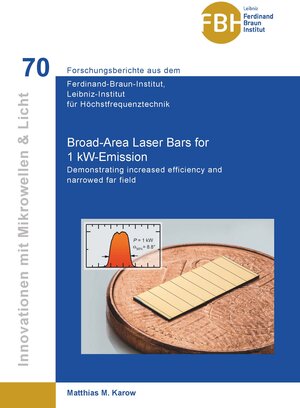Broad-Area Laser Bars for 1 kW-Emission
Demonstrating increased efficiency and narrowed far field
von Matthias M. KarowIndustrial laser systems for material processing applications rely on the availability of highly efficient, high-brightness diode lasers. GaAs-based broad-area laser bars play a vital role in such applications as pump sources for high-beam-quality solid-state lasers and, increasingly, as direct processing tools.
This work studies 940 nm-laser bars emitting 1 kW optical power at room temperature, identifying those physical mechanisms that are currently limiting electrical-to-optical conversion efficiency as well as lateral beam quality. In the process, several diagnostic studies on bars with varied lateral-longitudinal design were carried out. The effects of technological measures for performance optimization were analyzed, yielding a new benchmark in efficiency and lateral divergence.
The studies into altered resonator lengths of 4 and 6 mm as well as fill factors between 69 and 87 % successfully reduce both the voltage dropping across the device and power saturation at high currents, enabling 66 % efficiency at the operation point. Concrete measures how to reach efficiencies ≥70 % are presented thereafter, showing that doubling the efficiency value of the first 1 kW-demonstration in 2007 – amounting to 35 % – is in near reach.
Investigation of the beam quality bases on a herein proposed and realized concept, in which the far field is resolved for each individual bar emitter. In this way, it is possible to determine how far-field profiles vary along the bar width and how much these variations affect the overall bar far-field. Further, such effects specific to bar structures can be separated into non-thermal and thermal influences. The effect of mechanical chip deformation (bar smile) as well as neighboring-emitter interaction has been investigated for the first time in active kW-class devices, yielding a lateral divergence as low as 8.8° at the operation point.
This work studies 940 nm-laser bars emitting 1 kW optical power at room temperature, identifying those physical mechanisms that are currently limiting electrical-to-optical conversion efficiency as well as lateral beam quality. In the process, several diagnostic studies on bars with varied lateral-longitudinal design were carried out. The effects of technological measures for performance optimization were analyzed, yielding a new benchmark in efficiency and lateral divergence.
The studies into altered resonator lengths of 4 and 6 mm as well as fill factors between 69 and 87 % successfully reduce both the voltage dropping across the device and power saturation at high currents, enabling 66 % efficiency at the operation point. Concrete measures how to reach efficiencies ≥70 % are presented thereafter, showing that doubling the efficiency value of the first 1 kW-demonstration in 2007 – amounting to 35 % – is in near reach.
Investigation of the beam quality bases on a herein proposed and realized concept, in which the far field is resolved for each individual bar emitter. In this way, it is possible to determine how far-field profiles vary along the bar width and how much these variations affect the overall bar far-field. Further, such effects specific to bar structures can be separated into non-thermal and thermal influences. The effect of mechanical chip deformation (bar smile) as well as neighboring-emitter interaction has been investigated for the first time in active kW-class devices, yielding a lateral divergence as low as 8.8° at the operation point.







